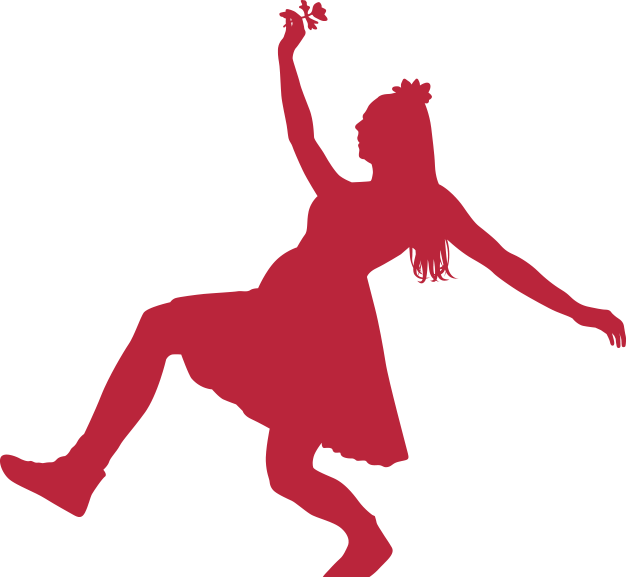The flop = failure and failure = death
Nov 05 2018
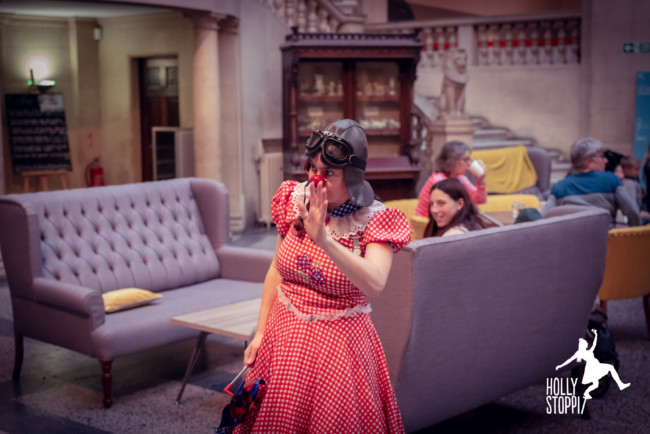
What I learned from Clowning in the Museum – Day 1
Last week, I spent three days in the Bristol Museum, as their Clown In Residence, bringing fun and laugher to family audiences inside Clowns: the Eggshibition.
Each morning, I spent an hour doing improvised red-nosed clowning, armed only with a rail full of costumes and a basket full of props. These were all suggested by people who'd completed my on-line survey, in which I'd asked people to tell me what they would like to see me wear, play with and do in my residency.
The hour-long improvisations were designed as performance research, to enable me to pick up where I left off in last year's Stage Fright project. As I explained in a previous blog, my research criteria for the clown in residence project consisted of 5 areas:
Self Connection (Am I allowing my real feelings to come into the play?)
Connection With Audiences (When is it easy? When is it hard and why?)
Being Witnessed (Am I allowing myself to be witnessed without reaching for direct connection? How is that?)
Collaboratively Discovered Play (Am I allowing the audience to collaborate in creating and developing the games? What impact does that have on the quality of play / connection?)
To Speak Or Not To Speak? (What impact does speaking or not speaking have on my quality of play / connection with audience?)
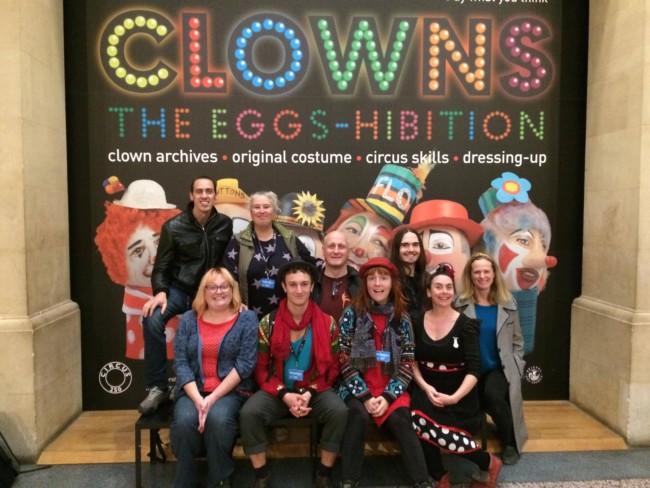
During each performance, I had a team of Play Enthusiasts (pictured above, there were nine in total, three came along each day). The Play Enthusiasts are all previous clown students of mine, who agreed to write about, draw, photograph and film the sessions, so that I could get an accurate record of what happened. At the end of each session, they interviewed the audience members to find out what they particularly enjoyed about their interactions with the clown. Back in the dressing room, I jotted down notes of my own. The following draws on all the data we collected.
This blog is all about the first day, if you want to read what happened on day 2, click here and if you want to read about day 3, click here.
Day One At The Museum
The time leading up to the residency had been an awkward tango of logistics and practicalities. I needed to organise my team of Play Enthusiasts, making sure they all knew what they were doing and when, I needed to gather all the props and costumes as well as working out what I was going to do in the twice daily family play sessions. I was chasing down red-noses, lost on their way from China and elusive rubber chickens, absent from every toy shop in Bristol. All of this on top of teaching my regular classes. Ordinarily this amount of work would be fine; as someone who thrives on variety, I'm used to juggling a huge amount of projects and holding a ridiculous amount of information in my head...but when there is also stage fright in the mix...
In the lead-up to the residency, my stage fright manifested as a total fixation on having All The Right Stuff, putting my focus onto something physical that I could control, rather than giving myself time to play, be, stretch and dance; all of which would perhaps have been better preparation for my first extended solo improvised public clowning in years, but all of which would have undoubtedly put me in touch with how terrified I was feeling about performing again. No no! Better to spend my time, joylessly gathering The Right Props; I turned Bristol up-side-down looking for a goddamn rubber chicken!
So when I turned up at the museum, I was coiled tight and about 5 foot outside my body. Normal, innocuous interactions had a tsunami of pressure behind them. What? There are no coat hangers? How will I hang my costumes? What? I can't get into the dressing room? How will I ever warm up? Everything felt like an emergency, even though I'd given myself plenty of time. Fear of failure, of public humiliation, turns little set-backs into overwhelming obstacles, which invariably leads to actual doom. As the Holly Stoppit textbook states: nerves create tension, which generally leads to pulling muscles, breaking stuff or generally being a dick.
The coat hangers miraculously appeared, thanks to my amazing host / bodyguard and exhibition curator, Amber. I managed to hang up all my costumes, set up my 'clown-in-residence' roped barriers and get into my dressing room with 20 minutes to spare.
Lining up a playlist of beautiful songs to stretch and dance to, I hoped that I could drag myself back into my body, release some tension and centre myself. I did everything in my power to keep myself in my experience, focussing on my body, on the ground and on my breath, but worry and panic had me jumping out to check my props and costumes, making sure that The Right Stuff was in The Right Place: back to the stuff fixation again! “Just 2 songs”, I told myself, “just roll around on the floor for 2 songs!” I managed one and a half.
For my first outfit, I chose something my 6-year old self might put together; a child-like red, white and blue gingham dress with fluffy red petticoat underneath, teamed with my brown leather flying hat and goggles. For my prop, I chose a shiny windmill.
Cautiously, I crept out of the dressing room, using my authentic feelings of shyness and amping them up. Entering the big, open front hall, I felt overwhelmed. There weren't many children there, so I hid around pillars, occasionally catching the eye of a grown up and playing at being shy, blowing on my windmill, as if trying to look nonchalant. One lady smiled at me, and I caught a gust of confidence that propelled me across the hall, windmill twirling high in the air. I did it again and again, laughing madly with glee, until eventually, I built up enough courage to meet some children.
I ran into the back hall, where families sat at cafe tables and was spotted immediately by several children. I played the game of hiding, using whatever I could find; chairs, cushions, blankets, buggies, but was forever getting seen. At this stage I was non-verbal, using sounds but no words. The game of hiding felt clear enough to sustain without words. My confidence was building, it was time to enter the Eggshibition.
I spotted a boy through the window in the door to the Eggshibition. I caught his eye, he hid, I hid. I casually blew my windmill and it somehow hypnotised me, dragging me into the Eggshibition. Awaiting me was an audience, sat on the floor, waiting for a show. Now this, I wasn't expecting! In my imagination, I thought I would be doing low-key installation performance behind my clown-in-residence barriers, like a museum exhibit, for one or two people at a time, with little walkabout excursions, around the exhibition. But here was an audience – kids of all ages and their parents, sat waiting for a show.
I didn't have a show. All I had was a red nose, a rail of costumes, a basket of props and a willingness to play.
The heady concoction of their expectation and my stage fright flipped my switch to Hyper Performance Overdrive. I rummaged in the props basket and threw out game after game for 20 minutes, including:
Presenting the ukulele (1), demanding applause, making it bow and putting it away
Asking the audience to stroke the unicorn, “it's friendly” and then making it growl for a grown-up man
Singing into the egg whisk
Doing impressions of the clown eggs
Presenting the ukulele (2), demanding applause, making it bow and putting it away
Being a horse, getting kids up to be horses, doing horsey tricks
Asking kids what else we should have in our circus? They replied “Minions”
Inviting kids up to be minions on trapezes
Presenting the ukulele (3), demanding applause, making it bow and this time singing “I Love To Laugh” from Mary Poppins, with an all-join-in chorus of “Ha-ha, ha-ha.”
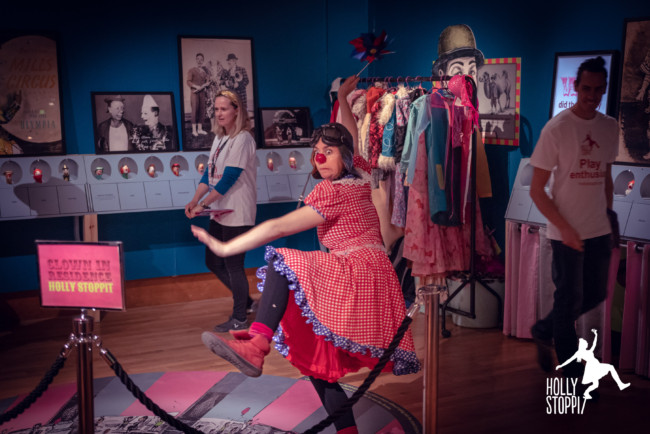
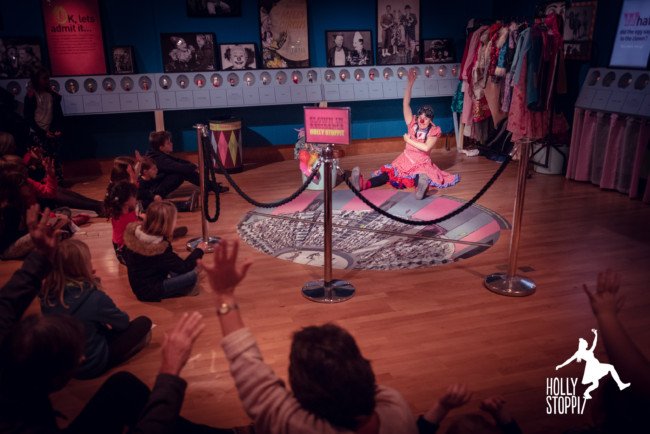
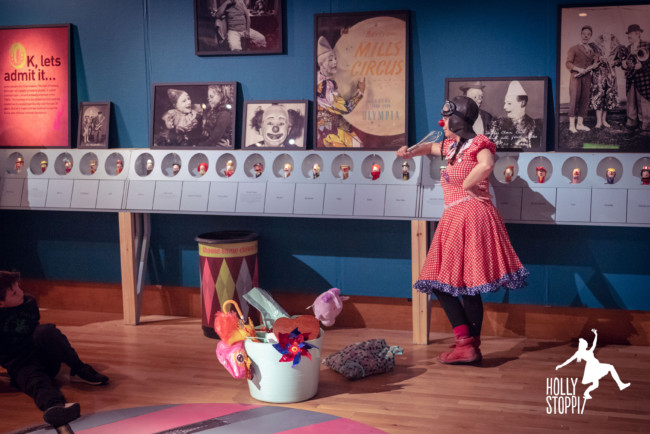
Phew! What a lot of ideas. All presented and chucked away within seconds. No time for development, no chance of a pause to breathe, just a scattergun of concepts – How about this? How about this? How about this? My language increased in direct relation to the stoney faces I was perceiving, as I struggled to get my material across. But I was shooting down my ideas before they had a chance to flop, because flopping = failure and failure = death and I wasn't going to die today! No Siree!
This all felt strangely familiar... aha! ...this was the rhythm of Holly Stoppit from the olden days, the one who never stopped for fear of the audience seeing her vulnerability. The one who projected her own inner critic onto audiences and made herself work harder and harder until she dropped.
I am not she any more. I am braver, more solid and more free than I've ever been. After a 7 year break from performing, where I retrained as a dramatherapist, undergoing huge chunks of therapy, many hours of meditation and copious amounts of reading, I feel like a different person. Yet faced with familiar triggers: the expectant audience + fear of death = old coping mechanisms come to the surface.
There was part of me able to watch all this happening from the outside, the kindly and accepting witnessing part of me, who placed her hands on her heart and said “Aww! You!” She was the one who suggested I should stop after 20 minutes, instead of doing the full hour. She knew I could sustain the audience's attention for 20 minutes and worked with my inner dramaturg to come up with a simple rule-of-three format, using the ukulele game as an anchor point to come back to and eventually develop into a finale.
This is what's different. Through all the work I've done on myself, this compassionate witnessing part of me helps me to receive myself just as I am, I do not need to be perfect to win my own affection.
Later that day, on the walk home, I tasted the beginning of a Shame Crash. I'd begun projecting my inner critic onto my Play Enthusiasts, the amazing people who'd given their time freely to support me. I'd started up a narrative in my head where they were judging me as a performer and therefore as a teacher, by the time I reached my house, they'd exposed me on social media and my teaching career had ended. Luckily the kindly witness walked along side me, gently stretching out the space around these thoughts, giving room for curiosity and inquiry. Although the taste of shame was in the air and part of me would've loved to dive headlong into a self-flagellation frenzy, I made the wiser choice of running a bath and finding a nourishing book to read.
I read a chapter from When You're Falling, Dive by Mark Matousek, a brilliant collection of true short stories and theory about people who've travelled through crisis and out the other side, rising like phoenixes into unexpectedly bountiful futures. In the chapter, 'The Water or The Wave?' Matousek interviews Mr. Power Of Now, Eckhart Tolle, who explains:
“Fighting, defending, storing information, analysing – this is what the conventional mind is good at...but it is not at all creative. All true artists create from a place of no-mind, from inner stillness, whether or not they're aware of it.”
I thought back to my preparation for this performance, remembering my cognitive approach of getting fixated on Getting The Right Stuff Together, as opposed to playing, resting and dreaming, the activities of “no-mind”. It's little wonder that the voice of fear was at the forefront, when meeting the audience for the first time. Hunkering down into the defended position, I let my inner critic tell me about what the audience was expecting. “It's got to be good and it's got to be funny!” The impact of my “clairvoyant” critic creates a pressure cooker, which puts me outside myself and into a desperate dance of trying to appease the demons. As a clown teacher, I know, nothing can be “good” or “funny” without time for discovery and / or development. But both discovery and development plunge us into the unknown and the unknown makes us feel vulnerable. The inner critic will do anything to “help” us not feel vulnerable. Because for the critic, vulnerability = failure and failure = death.
Back to you, Eckhart Tolle: “When we can yield, accept, be open to our lives, a new dimension of consciousness opens up...If action is possible or necessary, your action will be in alignment with the whole and supported by creative intelligence.”
If I had been able to embrace my vulnerability and allow the audience to share my predicament, eg “Wow, there's so many of you, I hadn't expected so many people! This is a bit scary!” then I could have let them into my world and made them my co-conspirators instead of my judges: “What do you think we should do?” This would have made for a much more connected experience – finding out what they actually wanted, as opposed to what my “psychic” critic was telling me they wanted.
As a performer, I have always been happiest when responding to audience suggestions. I trust myself to “misinterpret” their requests or do what they ask me to, only in a ridiculous fashion. There is a magic that happens when audiences can see their suggestions taken and explored on the stage. And not just for the person who suggested the idea, this person automatically becomes the voice of the whole audience and everybody gets to feel a sense of ownership over the material that ensues.
So how to engineer this sense of collaboration with audiences? Eckhart Tolle again: “If the shutters are closed, the sunlight can't come in. The universe will not be on your side; life will not be helpful.” How do I keep the shutters open when fear is causing me to close down? I know the theory, because I teach it! I tune into “no-mind,” I ground myself, I take my time, I breathe a little deeper, I look out and see the audience as a collection of vulnerable individuals who are also seeking connection. I let my actions come out of this space and my actions will be “in alignment with the whole and supported by creative intelligence.”
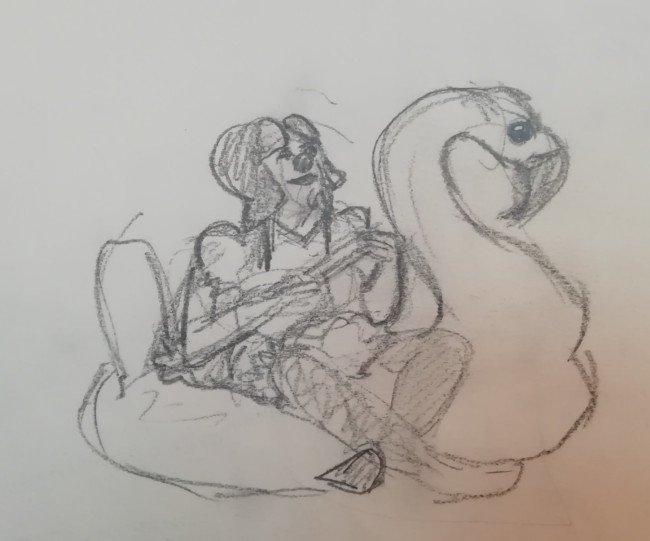
The surprise second show
After I'd released my audience into the Eggsibition, I pulled my clown-in-residence roped barriers into a little triangle and stood inside them, trying to blow up a huge inflatable flamingo. I wasn't reaching out for an audience, I was just focussing on trying to do my task well. Slowly an audience started to gather and I made a little eye contact to let them know they were welcome to stay and watch. I carried on with my task.
One little girl said “You need a pump!” So I tried the egg whisk, then the hobby horse as a pump – they didn't work, so I carried on blowing it up with my mouth. I was getting tired and hot, so I amped up both feelings until I “collapsed” on the floor. I recruited Neil, one of the Play Enthusiasts to carry on blowing up the flamingo, while I sat and watched with the audience. “You need a pump” they shouted again. So I invited a little girl to pump Neil's hand up and down while he blew up the flamingo. “You need a pump” shouted the others. One by one, I got them all up in a line, each pumping the last one's arm up and down.
Neil finally pumped up the flamingo and I sat on it, in my clown-pen, playing my ukulele and singing “When you're smiling.” More people gathered around to see what was happening. I asked them what costume I should put on, someone suggested the brightly coloured rain coat, so I did, reaching for my duck umbrella and dancing around the Eggshibition singing “I'm Singing In The Rain,” splashing in imaginary puddles and inviting children to join in.
“It's not raining!” They shouted. I licked my hand and put it out. “Look, my hand's wet, it must be raining!” “Eurgh! You just licked your hand!”, “I didn't, that would be disgusting” I licked my other hand “Look it's wet, it must be raining,” “Eurgh! You just licked your other hand!” “No I didn't, that would be disgusting” I licked my knee, the other knee, my ankle, each time, we played the game of “Eurgh! You just licked your ...!” “No I didn't, that would be disgusting.” Until eventually someone shouted “Don't lick your body!” “Well OK,” I started pretending to lick the clown eggs. “Don't lick the clowns” “I wouldn't do that, because CLOWNS TASTE FUNNY! (ba-dum chuh!)” The kids started pretending to lick me. I asked them what flavours the different sections of my coat were – apparently clowns taste of strawberry, lime, custard and blueberry.
This show felt a lot easier and more connected, because it began from stillness, I gave myself a task to do and committed to it, I allowed my real feelings to be seen and I allowed the audience to be equal collaborators. One of my Play Enthusiasts wrote:
“When blowing up the flamingo alone, there were moments of connecting but also fairly long spells of just blowing up the flamingo and being witnessed doing that. Felt like it built the basis for the later connection (everyone holding hands and pumping) because what you were doing and how committed you were to it was very clear... the commitment and time overrides any scepticism about what you're doing and why.”
Another Play Enthusiast commented; “That group seemed like they were your friends, and felt you were their friend.” The audience were quoted as saying:
“I like that flamingo.”
“I liked that we could take part”
“Holly is very in touch with the children. You don't normally get them engaged for so long.”
(controversially) “He's really funny, he's got a red bump on his nose.”
“I liked getting told off by the ugly actor”
“Holly was a happy and serious clown.” (I'd like this one on my grave stone please)
So what did I learn?
Self Connection – Fear puts me outside myself and makes my authentic emotions unavailable to play with.
Connection With Audiences - When I let fear run the show, I perform at audiences, throwing out 900 ideas a second, not leaving space for their responses. When I commit to a simple task and allow myself to be witnessed performing that task, true connection can begin.
Being Witnessed, Just "Being" - This is impossible when fear is running the show, as I'm running around like a headless chicken, trying to please all the people all the time. If I'm able to engineer time and space to be and be witnessed at the start of a performance, great things can happen.
Collaboratively Discovered Play - When fear is running the show, I haven't got time for anyone else's ideas and anyway, my inner critic thinks it's cheating to come onto stage with no ideas of my own. I am a highly trained clown, I should be able to come up with all the material by myself! When fear has been put down for a little nap, there is enormous amounts of joy in co-creating games, both for me and the audience and what we come up with is bigger than the sum of it's parts.
To Speak Or Not To Speak? - I enjoyed meeting the audience non-verbally. Using sounds and occasional single words like “hello” to make connections. As the pressure increased, I used more and more words, until I was spouting whole sentences, my Play Enthusiasts all commented that this actually helped ease the tension and bring about more connection – letting the audience know what the game is and how they can join in. After I released the first audience, I went back to non-verbal play, using sounds, single words and occasional short sentences – this felt like enough language to sustain the play / connection, as I was taking more time to establish the games, allowing the audience to co-create the rules.
What a lot of learning for one day! Thanks for reading. I hope it was helpful to you.
Wanna know what happened on day two or day three? Click away and find out!
Do have a peek at my upcoming activities as Bristol Museum's Clown In Residence.

